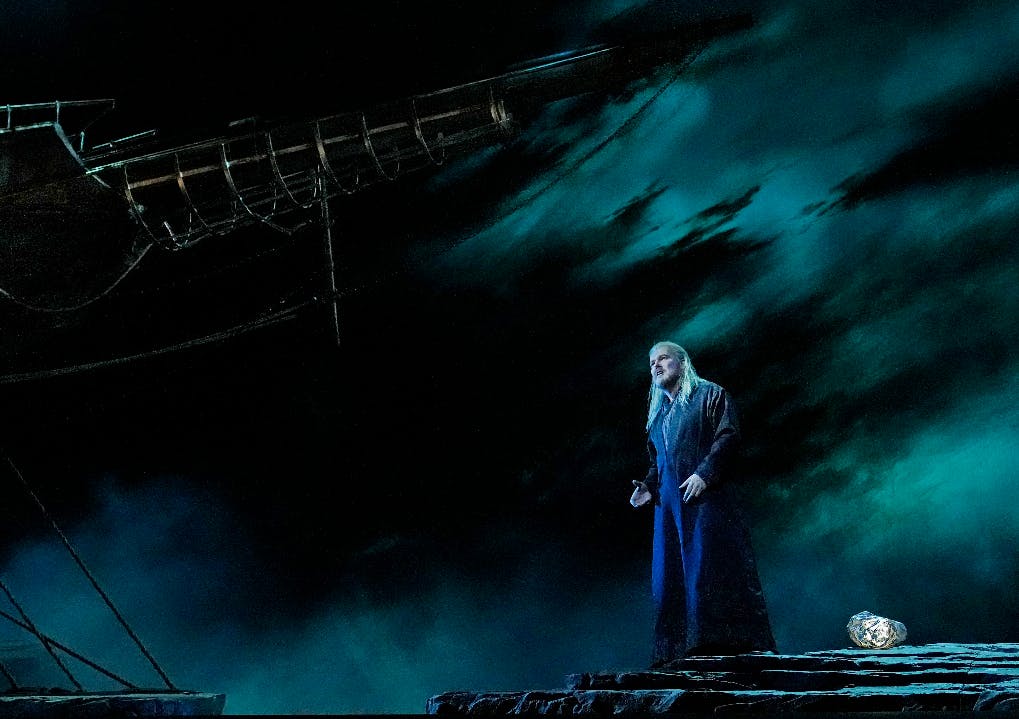Wagner’s Ghostly Seafaring Tale of Love and Redemption Returns After Covid Cut Short Its Debut
Wagner never could get over the idea that in order for mankind to be saved a woman needed to pay the price. From ‘Tannhäuser’ to ‘Götterdammerung,’ his works’ motto could well be ‘It ain’t over ’til the heroine dies.’

Richard Wagner: “Der Fliegende Hollander”
Metropolitan Opera
Through June 10
Rapidly bowed strings followed by triumphant horns — we hear the familiar overture, a popular concert piece, playing the role of the turbulent sea itself. A scrim veil occupies the foreground, filled with captivating projections of abstract patterns. We see the massive eye — of the storm? — from the earlier curtain, now projected on the back wall. A red figure appears. It must be Senta.
The woman pantomimes the action of the play, from the raging sea to her own death — a visual overture. The projected patterns give way to recognizable imagery: a ship, but spectral and made of stars. A constellation, by which sailors once navigated, is now upside down, spinning and layered. We’re lost. Is the fog real or illusion?
So begins the Met’s recent production of Wagner’s “Der Fliegende Holländer,” cut short in its 2020 debut due to Covid after merely three performances and reappearing for the first time last night. Hopefully the long rain delay will not dampen the impact of Canadian François Girard’s excellent treatment of this ghostly seafaring tale of love and redemption.
Mr. Girard previously staged “Parsifal” here in 2013 with similarly evocative and fresh stagecraft, forging a visual link between this, the earliest of Wagner’s works in the Bayreuth canon, and his last.
The conductor, Thomas Guggeis, 29, who will become music director of the Frankfurt Opera this fall, was spritely, assured, and light on his feet, moving with freedom, discipline, and a visible passion for the music. His baton articulated minute precision and could turn on a dime to gesticulate the sweeping grandeur of the score.
In the first scene, a mass of choral seamen form a strong horizontal band across the stage. Muted blue-greens dominate the dimly lit fjord-scape. Daland, sung by Ukrainian bass Dmitry Belosselskiy, is suitably booming, suggesting a sly buffoonery throughout in his portrayal of a man for whom fortune is worth more than love.
The helmsman sings to his lass while northern lights twinkle and he drifts off to sleep, unaware of the eerie entrance of the Dutchman, the captain of a ghost ship, cursed to spend eternity wandering the sea unless he finds a faithful woman.
Polish bass-baritone Tomasz Konieczny is immediately captivating in the title role as he solemnly eases into “Die frist ist um” (the time has come), his vibrato lending an authentically supernatural quality. “Release me,” he sings.
As Wagner intended, there are no intermissions, and we get a smooth transformation into Act II, whereupon we are greeted by an industrious army of cheerfully singing women. The chorus twirls ropes, which have descended from the ceiling, an excellent use of the Met’s daunting verticality.
It’s a long way from Sturm und Drang to “Summ und brumm,” and this kind of set piece is largely absent from Wagner’s later work, but it does provide refreshing levity.
Senta, sung by soprano Elza van den Heever, enters with a subdued tone and begins a slow build. She’s in love with a picture on her wall — that massive eye, again, like an oversized Cure poster on a goth teen’s wall. Against the objections of her nurse, Mary, Senta begins her ballad, “Traft ihr das Schiff,” casting a spell and conjuring the Dutchman, the workers’ white dresses now turned red by the lights.
The unmistakably Wagnerian melody features vocal athleticism — a piercing high note, followed by a big drop, which she executes flawlessly, building into the music’s ensuing less repetitive structures. The ropes are no longer being spun and have been left in forms suggesting ship’s rigging, or, perhaps, Fred Sandback sculptures.
Erik, a mere mortal, implores Senta to stay with him. He is sung sweetly by tenor Eric Cutler, who endears us to the character, but also reveals a cloying possessiveness, true to the opera’s theme.
The couple look good together and the singers share chemistry in their duet, despite what fate has in store for them. “Do you want to destroy me?” demands Erik. “How can you be afraid of a song or a picture?” retorts Senta.
When Senta and the Dutchman meet, and sing their duet, “Wie aus der ferne” (“as if from afar”), the gravity of the situation increases. Senta mysteriously cups her hands around the Dutchman’s head, perhaps afraid to touch it. Isn’t this guy a thousand years old?
The music swells, the background recalls Turner paintings, and the men’s and women’s choirs both appear, separated, almost squaring off, moving as though they were the sea itself. “Only a woman can free me from this curse,” sings the Dutchman, and he gets his wish.
Wagner never could get over the idea that in order for mankind to be saved a woman needed to pay the price. From “Tannhäuser” to “Götterdammerung,” his works’ motto could well be “It ain’t over ’til the heroine dies.”
It can be dangerous to take some of the composer’s more dubious themes and ideas too literally, and this staging, which is neither as abstract as Wieland Wagner’s austere 1950’s creations, nor as pedestrian as the traditional Met rendition that it supplants, provides new relevance for one of Romanticism’s core concepts: the Gesamtkunstwerk.

